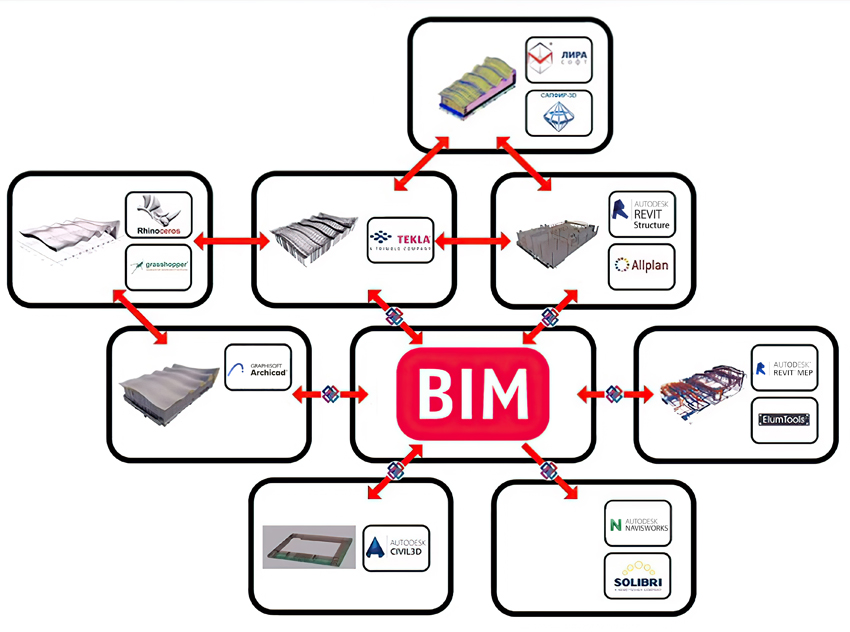The Future is BIM
 1 AIA LU/Elective; 0.1 ICC CEU; 1 IIBEC CEH; 0.1 IACET CEU*; 1 AIBD P-CE; AAA 1 Structured Learning Hour; This course can be self-reported to the AANB, as per their CE Guidelines; AAPEI 1 Structured Learning Hour; This course can be self-reported to the AIBC, as per their CE Guidelines.; MAA 1 Structured Learning Hour; This course can be self-reported to the NLAA.; This course can be self-reported to the NSAA; NWTAA 1 Structured Learning Hour; OAA 1 Learning Hour; SAA 1 Hour of Core Learning
1 AIA LU/Elective; 0.1 ICC CEU; 1 IIBEC CEH; 0.1 IACET CEU*; 1 AIBD P-CE; AAA 1 Structured Learning Hour; This course can be self-reported to the AANB, as per their CE Guidelines; AAPEI 1 Structured Learning Hour; This course can be self-reported to the AIBC, as per their CE Guidelines.; MAA 1 Structured Learning Hour; This course can be self-reported to the NLAA.; This course can be self-reported to the NSAA; NWTAA 1 Structured Learning Hour; OAA 1 Learning Hour; SAA 1 Hour of Core Learning
Learning Objectives:
- Describe how BIM software plays a role in an architecture firm’s project productivity and strategic initiatives.
- Explain how OPEN BIM leads to seamless collaboration and transparency.
- Discuss the benefits of using BIM's fluid design capabilities.
- List examples of how BIM supports virtual collaboration using digital delivery.
This course is part of the Business of Architecture Academy
The Value of Open BIM Collaboration
In the AEC industry, a variety of disciplines must come together to execute one project, and this is a difficult task. In the past, architects and engineers—structural, mechanical, electrical, and plumbing—have relied on a workflow that operated in phases designated and often segregated by each discipline.
The BIM model allows these disciplines to work together simultaneously or in a more flexible manner. This means that each discipline can contribute early in the design process, allowing for more integrated design planning and the ability to pitch in with knowledge or support throughout the entire process. This means that conversations about materials and building orientation that might otherwise happen separately would become more informed and mutually beneficial in a collaborative process.
But it is the mechanisms of open standard that allows this collaboration to physically take place. Different disciplines require different forms of data. To operate and exchange data between software platforms, while still complying with international data standards, open BIM uses data exchange formats such as industry foundation classes (IFC), which is the core standard for open BIM data exchange. BIM CAD software for Macintosh and Windows offers out-of-the-box design documentation, one-click publishing, photo-realistic rendering, and high-end analysis. Different stakeholders can exchange data no matter their chosen software or tools, which means that they can choose the tools that best fit their jobs. An architect might create a design model and export an IFC version to share with an HVAC engineer, who can use the information to coordinate the job using entirely different tools. Together, the architect and engineer might do an early energy analysis on the building that can help inform the project along the way.
Open BIM is a vendor-neutral, modern approach to collaboration that is open to all software vendors, AEC practices (designers, engineers, and builders), and built asset owners. An open BIM collaboration also includes clients, construction teams, and others who are invested in the project. A collaborative model-based approach means that everyone can be on the same page from the beginning, providing the potential to reduce costs due to changes in design and possibly reducing litigation risks. If everyone agrees on decisions early on, they are less likely to change or become miscommunicated later in the process.
Open BIM allows all collaborators to comment, ask questions, and provide feedback along the way. It allows disciplines that often adhere to their own specifications to communicate a better approach so that project reworks that are often costly are less likely to happen. Open BIM also allows collaborators from different disciplines to work on an agreed timescale that can be adjusted in a seamless fashion. This more predictable approach helps saves time and allows departments to allocate resources more efficiently.
Departments are able to run real-life scenarios for the model. When an environmental or financial factor affects an aspect of the project, its potential effect on all the other departments can be easily seen through simulation. If one department needs to tweak a design, other departments can see how that tweak will affect their roles in the project and adjust accordingly.
The seamless workflow of collaboration and the transparency of working on a shared model builds trust among team members and eliminates model duplication and other redundant work between architects and structural engineers. Open BIM extends the benefits of BIM by improving the accessibility, usability, management, and sustainability of digital data in the AEC industry. And this can lead the whole industry in building and operating better buildings thanks to seamless collaboration, transparency, quality assurance, and accessible data.
DESIGN CAPABILITIES WITH BIM WORKFLOW
Working in 3-D software that allows for real-time collaboration sounds complicated, but understanding the tools and concepts can create a more streamlined workflow. This section will talk about the capabilities of the software for different industry players and provide some examples and illustrations of what BIM can accomplish.
BIM versus 2-D and 3-D Drafting Systems
Both BIM and traditional 2-D drafting work well to create construction documents, such as floor plans, elevations, and details. But one of the ways that BIM and 2-D CAD differ is in how they deal with geometric shapes. 2-D CAD software is limited to using lines to create geometric shapes that represent real objects. BIM platforms, however, involve geometry that includes real-life information, such as the weights and volumes of the building materials. BIM also makes modeling simple, and it has the added features of generating project cost structures, which allows for collaboration and managing changes within the project.
All objects in a BIM project are linked, and changes in design are automatically updated in other areas, such as schedule and cost. This function is known as bidirectional associativity, and it is one of the main reasons that architects shift to BIM. For example, in a BIM project, a change to a window will result in an automatically updated window schedule. A change to a window in a CAD project, however, requires that the plan, section, election, and schedule all need to be updated separately. In short, BIM guards against mistakes while saving the architect time.
While 3-D drafting systems such as 3-D CAD are still very useful for designing building documents, they are limited in comparison to BIM platforms. Where 3-D CAD systems identify individual objects (e.g., walls, bricks, etc.), BIM easily can integrate manufacturer product specifications right into the design. These specifications go beyond the basic objects available in CAD systems. More importantly, BIM is a process that considers the full life cycle of the building, not just the initial design. This means that every element of the building design can be specified for performance requirements (e.g., energy efficiency, thermal, sound). Once the building is complete, these requirements can be verified. BIM streamlines this process for building professionals.
Specific BIM Tools for Every Discipline
BIM platforms allow architects to design and develop much more realistic and accurate renderings than are possible with CAD software. With BIM, they can quickly communicate with the client via 3-D images during the design process. This benefit aids in the overall project communication, and allows professionals down the project line to better visualize the original design. Moreover, it helps to reduce conflicts between members of the project team early on, reducing both errors and omissions. This benefit is seen directly through reduced project time, more accurate material estimates, and better predictions of overall costs and schedule.

Image courtesy of CPU Pride
Outlined here is the scheme of the stakeholder interactions during the BIM design development phase.

A BIM model can address all aspects of the building, such as entrance and egress, sprinkler systems, and stairwell design and safety, not to mention the flammability of internal building materials.
Another way that BIM can help the individual architect is through greater efficiency. BIM makes it easy for architects to do the work that once required a team of several people. This way, they can either provide more services for the same fee or reduce fees in order to become more competitive, all while maintaining close control over the project.
Two other useful advantages are clash detection and directional associativity. Clash detection is used when the architectural, mechanical, and structural models are brought together, and it shows all of the places where a duct and beam collide. BIM uses bidirectional associativity by storing the model information in a single coordinated database, which means that any revisions are automatically updated throughout the model.
A final advantage is that BIM’s centralized database means that detailed 3-D presentations are easy to generate, and the data can be accessed anywhere, from any device.
Much like the architects on a project, builders benefit tremendously from the ease of communication offered by the BIM platform. This streamlined communication and access to real-time changes with plans means that there are fewer conflicts and so reduced changes during construction.
The production and scheduling tools available through BIM also help builders plan more accurately the specific materials and products that are needed for construction. The details of these tools are discussed in the next section.
Between knowing materials and precise quantities, and being able to schedule project timelines more accurately, builders are able to better predict the outcomes of the project. More often than not, this outcome is higher quality than buildings constructed without the benefits of BIM.
Many performance-modeling tools exist as plug-ins for BIM. These tools can be used for building performance analysis (BPA), which can help architects design more sustainable buildings, or to assess construction practices and eventual performance.
Designers can use the complex information available through BIM, such as type of space, specific properties of materials, a building’s physical location with typical environmental temperatures, and sun and wind patterns. With this information, they can simulate whatever project requirements they might have. For example, before construction, designers may want to know optimal HVAC size or what the structure’s airflow, light levels, or estimated water use may be. For sun path studies, BIM allows architects to place a model in the exact geographic location and orientation that it will have in the real world, and see how it reacts to the sun position on any day or time of the year. BIM allows these analyses to be done prior to construction as well as after. Such studies are usually done at the same time as energy analyses.
Designing for Health and Human Welfare
BIM’s role in modeling for health and human welfare and safety can be tremendous. Architects and builders can help reduce risks and communication mishaps simply by having explicit design information available to each other within the same virtual space. This point alone can help address other elements of quality control.
While air quality can be considered a comfort aspect of a building, it also directly impacts the health of the occupants through proper airflow and circulation.
BIM can be used when designing for emergency situations, such as fires or natural disasters. The model can address all aspects of the building, such as entrance and egress, sprinkler systems, and stairwell design and safety, not to mention the flammability of internal building materials. Similarly, BIM can also be used to design more accessible buildings.
Finally, BIM can help make sure building operations run smoothly, which can enhance the overall well-being and safety of the occupants throughout the building’s lifetime.

In the world of AEC, cloud-based BIM is a powerful technology because multiple stakeholders can interact with the exact same bit of information simultaneously.











